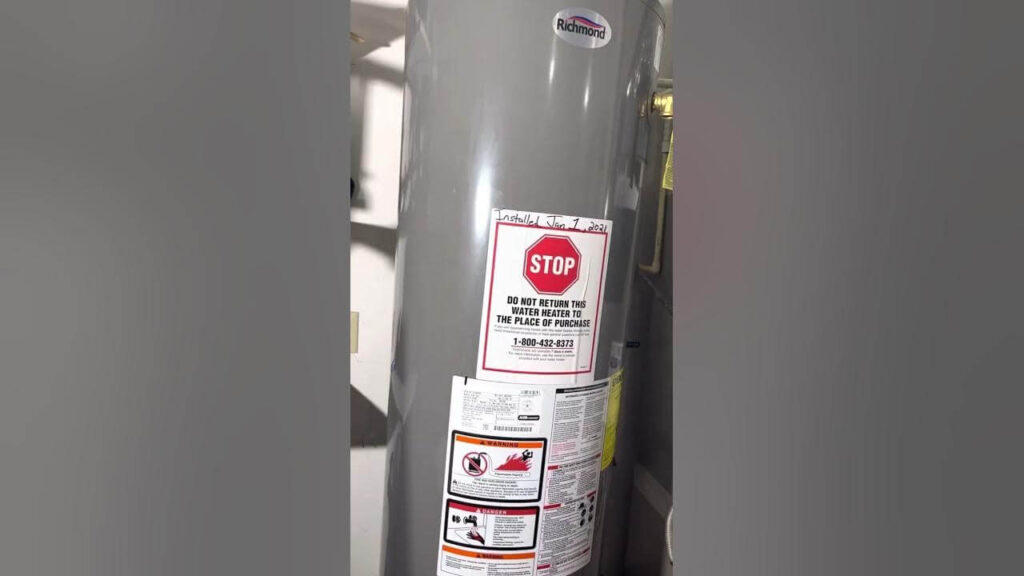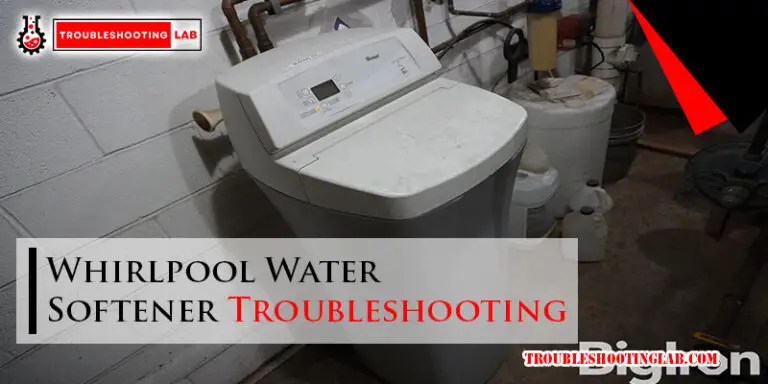Richmond Water Heater Troubleshooting: Expert Solutions
If you’re experiencing troubleshooting issues with your Richmond water heater in Austin, Texas, the best course of action is to consult a professional plumber for repairs or replacements. Common problems that may arise include pilot light issues, thermostat control malfunctions, power vent complications, or gas valve problems.
Addressing these concerns promptly is essential to restoring hot water to your home. Additionally, careful troubleshooting and regular maintenance can help prevent water heater failure caused by factors like rust and eroded anodes. Remember to drain your water heater periodically to keep it in optimal condition and consult the manufacturer’s manual for specific troubleshooting steps.

Common Issues With Richmond Water Heaters
Richmond water heaters are known for their durability and efficiency. However, like any appliance, they can experience common issues that may require troubleshooting. In this section, we will discuss some of the most common issues with Richmond water heaters and provide solutions to help you resolve them.
Gas Valve Problems
One of the common issues with Richmond water heaters is related to gas valve problems. The gas valve is responsible for controlling the flow of gas to the burner, which heats the water. When the gas valve malfunctions, it can cause a variety of problems, including:
- No hot water
- Inadequate hot water
- Water not getting hot enough
If you are experiencing any of these issues, it is important to check the gas valve. First, ensure that the gas supply is turned on. If the gas supply is on and you are still not getting hot water or the water is not hot enough, you may need to replace the gas valve. Consult a professional plumber for assistance with gas valve replacement.
Pilot Light Keeps Going Out
Another common issue that Richmond water heater owners may encounter is a pilot light that keeps going out. The pilot light is the small flame that ignites the gas burner when the water heater is turned on. If the pilot light keeps going out, it can prevent the water heater from working properly.
The most common reason for a pilot light going out is a faulty thermocouple. The thermocouple is a safety device that detects whether the pilot light is lit. If the thermocouple senses that the pilot light is not lit, it shuts off the gas supply to prevent a potential gas leak.
To troubleshoot a pilot light that keeps going out, follow these steps:
- Turn off the gas supply to the water heater.
- Wait a few minutes for any lingering gas to dissipate.
- Relight the pilot light according to the manufacturer’s instructions.
- If the pilot light continues to go out, it may be necessary to replace the thermocouple. Consult a professional plumber for assistance with thermocouple replacement.
By addressing gas valve problems and pilot light issues, you can ensure that your Richmond water heater operates efficiently and provides reliable hot water. If you are unsure of how to troubleshoot or resolve these issues, it is recommended to seek the help of a professional plumber to avoid any potential safety hazards.
Troubleshooting And Solutions
Having trouble with your Richmond water heater? Don’t worry, we’ve got you covered! In this section, we will explore some common troubleshooting tips and solutions to help you get your water heater up and running again. From checking the thermocouple for gas valve problems to fixing issues with the pilot light and no hot water, we’ll guide you through step-by-step.
Check Thermocouple For Gas Valve Problems
If your Richmond water heater is not producing hot water, one possible cause could be problems with the gas valve. The thermocouple is a small device located near the burner that senses the pilot light’s heat. It sends a signal to the gas valve to allow the main burner to operate.
To check the thermocouple, follow these steps:
- Turn off the gas supply to the water heater.
- Remove the access panel to expose the gas valve and thermocouple.
- Inspect the thermocouple for any signs of damage or wear.
- Clean the thermocouple using a soft cloth or fine-grit sandpaper to remove any dirt or corrosion.
- Ensure that the thermocouple is securely connected to the gas valve.
- Turn on the gas supply and attempt to relight the pilot light.
- If the pilot light stays lit and the main burner ignites, the thermocouple is functioning properly. If not, you may need to replace the thermocouple or consult a professional.
Possible Causes Of Pilot Light Going Out
If the pilot light on your Richmond water heater keeps going out, there could be several reasons for this issue. Some possible causes include:
- A faulty thermocouple
- A draft or improper ventilation
- A dirty or clogged pilot orifice
- A gas supply issue
- A malfunctioning gas valve
To determine the cause and fix the problem, try the following:
- Check if the thermocouple is properly positioned and secure.
- Ensure that there are no drafts or obstructions near the water heater.
- Inspect the pilot orifice and clean it if necessary.
- Verify that there is an adequate supply of gas to the water heater.
- If these troubleshooting steps do not resolve the issue, it is best to consult a professional technician to diagnose and repair the problem.
Fixes For No Hot Water
If you’re experiencing a lack of hot water from your Richmond water heater, there are a few potential fixes you can try:
- Check the thermostat settings on your water heater and ensure they are set to the desired temperature.
- If you have an electric water heater, make sure it is receiving power by checking the circuit breaker.
- If you have a gas water heater, verify that the pilot light is lit. If not, follow the steps outlined earlier to troubleshoot the pilot light issue.
- If none of these steps resolve the problem, it may be time to call a professional to inspect and repair your water heater.
Remember, proper maintenance and regular inspections can help prevent many of these issues from occurring. If you’re unsure about performing any troubleshooting steps yourself, it’s always best to consult a professional to avoid further damage or safety hazards.
Preventing Water Heater Failure
Prevent water heater failure with proper Richmond water heater troubleshooting in Austin, Texas. Get expert help to identify and fix common issues like pilot light problems, thermostat control repair, and heating element failure for uninterrupted hot water supply.
Understanding Sacrificial Anodes
One of the most effective ways to prevent water heater failure is by understanding sacrificial anodes. These anodes are crucial components that prevent the corrosion of the water heater’s metal inside the tank. Sacrificial anodes are made of a more reactive metal, such as magnesium or aluminum, which corrodes instead of the tank’s metal.
The sacrificial anode attracts the corrosive elements in the water, protecting the tank from rust and eroding. However, over time, these anodes become depleted and need to be replaced to continue protecting the water heater.
Replacing Sacrificial Anodes
To ensure optimal performance and prevent water heater failure, it is essential to replace sacrificial anodes regularly. When replacing a sacrificial anode, it’s important to choose the correct type and size that matches the water heater’s specifications.
Here is a step-by-step guide to replacing sacrificial anodes:
- Turn off the water supply to the water heater and disconnect any power source.
- Drain the tank by connecting a hose to the drain valve and releasing the water.
- Locate the anode rod’s access point on top of the tank.
- Unscrew the old anode rod using a suitable socket or wrench.
- Insert the new anode rod into the access point and tighten it securely.
- Turn on the water supply, allowing the tank to fill.
- Restore power to the water heater.
Other Causes Of Water Heater Failure
While sacrificial anodes play a vital role in preventing corrosion and water heater failure, there are other potential causes to be aware of. These include:
- Sediment buildup: Over time, minerals and sediment can accumulate at the bottom of the tank, reducing efficiency and potentially causing damage.
- Temperature and pressure relief valve failure: This safety valve releases excess pressure to prevent the tank from exploding. If the valve fails, it could lead to a dangerous situation.
- Thermostat issues: A malfunctioning thermostat can cause the water not to reach the desired temperature or may result in constant overheating.
- Gas valve problems: Faulty gas valves may cause issues with the ignition or temperature control of the water heater.
- Leaks: A leak in the tank or plumbing connections can result in water damage and require immediate attention.
Regular maintenance, proper usage, and addressing issues promptly can help prevent these causes of water heater failure.
Draining And Troubleshooting Richmond Water Heaters
Richmond water heaters are known for their quality and durability, but like any appliance, they can encounter issues from time to time. One common problem that homeowners may face is the need to drain and troubleshoot their water heaters. In this article, we will walk you through the steps to properly drain a Richmond water heater, as well as diagnose and repair common issues that may arise. Additionally, we will guide you through the process of resetting and checking different components to ensure your water heater is functioning optimally.
How To Drain A Richmond Water Heater
Draining a Richmond water heater is essential for maintenance and troubleshooting purposes. Follow these steps to properly drain your water heater:
- Turn off the power supply to the water heater. For an electric water heater, you can do this by flipping the circuit breaker. For a gas water heater, locate the gas shut-off valve and turn it to the “off” position.
- Attach a hose to the drain valve located at the bottom of the water heater. Make sure the other end of the hose is placed in a suitable drainage area.
- Open the drain valve by turning it counterclockwise. This will allow the water to flow out through the hose.
- Once the water has fully drained, close the drain valve by turning it clockwise.
- Remove the hose from the drain valve and ensure it is securely closed.
- Turn on the power supply to the water heater. For an electric water heater, flip the circuit breaker back on. For a gas water heater, turn the gas shut-off valve to the “on” position.
Diagnosing And Repairing Common Issues
Even with regular maintenance, Richmond water heaters can experience common issues that may require troubleshooting and repairs. Here are some common problems you may encounter:
| Issue | Possible Cause | Solution |
|---|---|---|
| No hot water | Faulty heating element, gas connection, or burner | Check and replace a faulty heating element if necessary. Ensure gas connection is secure and check the burner for any blockages or damage. |
| Pilot light keeps going out | Malfunctioning thermocouple | Have a professional HVAC technician check and replace the thermocouple if needed. |
| Water heater leaking | Corroded or damaged tank or fittings | Inspect the tank and fittings for any signs of corrosion or damage. Replace any faulty components. |
Steps To Reset And Check Different Components
If you are experiencing issues with your Richmond water heater, it may be necessary to reset and check various components. Follow these steps:
- Turn off the power supply to the water heater.
- Locate the reset button on the control panel of the water heater.
- Press and hold the reset button for a few seconds.
- Release the reset button and wait for a few minutes.
- Turn on the power supply to the water heater.
- Check other components such as the heating element, thermostat, and pressure relief valve for any signs of damage or malfunction.
- If necessary, replace any faulty components following the manufacturer’s instructions.
By following these steps and properly troubleshooting your Richmond water heater, you can ensure its longevity and efficiency. Regular maintenance and addressing issues promptly will help keep your water heater running smoothly for years to come.
Frequently Asked Questions
How Do I Reset My Richmond Water Heater?
To reset your Richmond water heater, follow these steps: 1. Locate the temperature adjustment dial on the front of the heater. 2. Turn the dial to the lowest setting. 3. Wait 5 minutes for the heater to cool down. 4. Turn the dial back to your desired temperature. 5. Wait for the heater to heat up the water. Source: Richmond Water Heater Troubleshooting – YouTube
Why Does My Richmond Water Heater Keep Going Out?
The most common reason your Richmond water heater keeps going out is a faulty thermocouple. HVAC professionals can quickly repair or replace the thermocouple to restore hot water in your home.
Why Is My Hot Water Heater Not Making Hot Water?
If your hot water heater is not making hot water, it could be due to various issues. Electric water heaters may experience a power loss or heating element failure, while gas water heaters may have problems with the gas connection, pilot light, or burner.
Get professional help to diagnose and fix the problem.
What Is The Most Common Cause Of Water Heater Failure?
The most common cause of water heater failure is rust. Over time, the sacrificial anodes, which prevent the metal in the heater from eroding, will start to erode themselves and need to be replaced.
Why Is My Richmond Water Heater Not Heating Up?
If your Richmond water heater is not heating up, it could be due to a power loss or a faulty heating element in electric water heaters, or a gas connection, pilot light, or burner issue in gas water heaters.
Conclusion
If you’re experiencing issues with your Richmond water heater, it’s essential to troubleshoot the problem for a quick and efficient resolution. From pilot light problems to gas valve issues, there are various potential causes for your heater not functioning correctly.
By understanding the common reasons behind water heater failures, such as rust or power loss, you can take appropriate action and ensure your heater is functioning optimally. Don’t hesitate to seek professional help from experienced HVAC technicians like DeltaTemp to restore hot water in no time.
Lastly, remember to regularly maintain and drain your Richmond water heater to prevent future issues.





